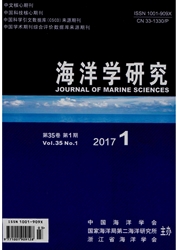

 中文摘要:
中文摘要:
根据"908"ST04区块调查的夏、冬、春、秋季四个航次和"908"补充调查的8月航次资料对长江口及邻近海区表层水体溶解氧及其饱和度进行了探讨。研究表明东海北部表层水体在夏季和春季以浮游植物光合作用为主要控制过程,特别是7、8月份长江口外、杭州湾外及浙江近海存在大范围的强光合作用区;秋季以有机质氧化分解过程为主,表层溶解氧处于不饱和状态;冬季溶解氧基本接近饱和,表明其主要受温度和盐度等物理因子控制。另外,发现杭州湾和长江口海区溶解氧常年处于不饱和状态,其原因是有机质氧化分解过程造成的。
 英文摘要:
英文摘要:
Based on the data collected during summer,autumn,winter and spring from July 2006 to October 2007 and August 2009,seasonal variations of the dissolved oxygen(DO) and its saturation degrees were analyzed for Changjiang River Estuary and its adjacent waters.The results show that phytoplankton photosynthesis was the dominant processes to control the surface DO saturation in summer and spring in the northern East China Sea,especially in July and August there were large areas of strong photosynthesis off Changjiang River Estuary,Hangzhou Bay and the coastal area of Zhejiang province.In autumn,oxidative decomposition of organic matter was dominant and surface DO was in unsaturated state.In winter,the DO was nearly saturated,which indicates that physical factors such as salinity and temperature were the main control factors.It is also found that DO was undersaturated throughout the year in Changjiang River Estuary and Hangzhou Bay,which might be resulted from the oxidative decomposition of organic matter.
 同期刊论文项目
同期刊论文项目
 同项目期刊论文
同项目期刊论文
 期刊信息
期刊信息
